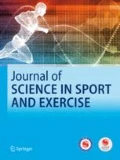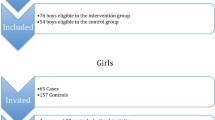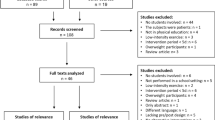Abstract
Background
Physical activity programs using components of resistance have the potential to improve health in school children. The purpose of this study was to examine the effect of a school-based resistance exercise program on physical fitness in elementary school students.
Methods
The sample was 256 children (mean age = 8.3 ± 2.5 years; 119 girls) from kindergarten to 5th grade. Participants performed a 10-min resistance exercise 2–3 times in each school day. Physical fitness outcomes were assessed using President’s Physical Fitness Challenge test. Measures were collected at baseline and at a 6-month post-test time point. A 2 × 2 doubly MANOVA was employed to examine the effect of sex and time.
Results
The multivariate model was statistically significant with a main time effect (Wilks’ λ = 0.19, F = 290.9, P < 0.001). Follow-univariate tests found significant differences between time-points on flex arm hang (P = 0.033), shuttle run (P < 0.001), and 1-mile run/walk times (P < 0.001).
Conclusions
A 6-month resistance exercise program improved upper body strength and cardiorespiratory endurance in elementary school aged children. The use of resistance exercise intervention during school day can be effectively used to promote physical fitness and ultimately improve the health of children.


Similar content being viewed by others
References
American College of Sports Medicine. ACSM’s health-related physical fitness assessment. 15th ed. Baltimore: Lippincott Williams & Wilkins; 2017.
Astorino TA, Rohmann RL, Firth K, Kelly S. Caffeine-induced changes in cardiovascular function during resistance training. Int J Sport Nutr Exerc Metab. 2007;17(5):468–77.
Behringer M, Vom Heede A, Matthews M, Mester J. Effects of strength training on motor performance skills in children and adolescents: a meta-analysis. Pediatr Exerc Sci. 2011;23(2):186–206.
Brooks G, Fahey T, White T. Exercise physiology. 2nd ed. Mountain View: Mayfield Publishing Company; 1996.
Brusseau TA, Hannon JC, Fu Y, Fang Y, Nam K, Goodrum S, Burns RD. Trends in physical activity, health-related fitness, and gross motor skills in children during a 2-year comprehensive school physical activity program. J Sci Med Sport. 2018;21(8):828–32.
Christou M, Smilios I, Sotiropoulos K, Volaklis K, Pilianidis T, Tokmakidis SP. Effects of resistance training on the physical capacities of adolescent soccer players. J Strength Cond Res. 2006;20(4):783–91.
Cohen J. Statistical power analysis for the behavioral sciences. Hillsdale: L. Erlbaum Associates; 1998.
Craig M, Hales MD, Carroll MD, Fryar CD, Ogden CL. Prevalence of obesity among adults and youth: United States, 2015–2016. NCHS Data Brief. 2017;288:1–8.
Eather N, Morgan PJ, Lubans DE. Improving health-related fitness in adolescents: the CrossFit Teens™ randomized controlled trial. J Sports Sci. 2016;34(3):209–23.
Faigenbaum AD, Lloyd RS, Myer GD. Youth resistance training: past practices, new perspectives, and future directions. Pediatr Exerc Sci. 2013;25(4):591–604.
Faigenbaum AD, McFarland J, Keiper F. Effects of a short term plyometric and resistance training program on fitness performance in boys age 12–15 years. J Sports Sci Med. 2007;6(4):519–25.
Faigenbaum A, Milliken L, La Rosa Loud R, Burak B, Doherty C, Westcott W. Comparison of 1 and 2 days per week of strength training in children. Res Q Exerc Sport. 2002;73(4):416–24.
Faigenbaum A, Myer G. Pediatric resistance training: benefits, concerns, and program design considerations. Curr Sports Med Rep. 2010;9(3):161–8.
Falk B. Muscle strength and resistance training in youth-do they affect cardiovascular health? Pediatr Exerc Sci. 2016;28(1):11–5.
Fu Y, Burns RD. Effect of an active video gaming classroom curriculum on health-related fitness, school day step counts, and motivation in sixth graders. J Phys Act Health. 2018;15(9):644–50.
Fu Y, Gao Z, Hannon JC, Burns RD, Brusseau TA. Effect of the SPARK program on physical activity, cardiorespiratory endurance, and motivation in middle-school students. J Phys Act Health. 2016;13(5):534–42.
Granacher U, Goesele A, Roggo K, Wischer T, Fischer S, Zuerny C, Gollhofer A, Kriemler S. Effects and mechanisms of strength training in children. Int J Sports Med. 2011;32(5):357–64.
Haskell WL, Lee IM, Pate RR, Powell KE, Blair SN, Franklin BA, Macera CA, Heath GW, Thompson PD, Bauman A. Physical activity and public health: updated recommendation for adults from the American College of Sports Medicine and the American Heart Association. Med Sci Sports Exerc. 2007;39(8):1423–34.
Hills AP, Dengel DR, Lubans DR. Supporting public health priorities: recommendations for physical education and physical activity promotion in schools. Prog Cardiovasc Dis. 2015;57(4):368–74.
Horner K, Barinas-Mitchell E, DeGroff C, Kuk JL, Drant S, SoJung L. Effect of aerobic versus resistance exercise on pulse wave velocity, intima media thickness and left ventricular mass in obese adolescents. Pediatr Exerc Sci. 2015;27(4):494–502.
Hu M, Finni T, Zou L, Perhonen M, Sedliak M, Alen M, Cheng S. Effects of strength training on work capacity and parasympathetic heart rate modulation during exercise in physically inactive men. Int J Sports Med. 2009;30(10):719–24.
Huggett DL, Elliott ID, Overend TJ, Vandervoort AA. Comparison of heart-rate and blood-pressure increases during isokinetic eccentric versus isometric exercise in older adults. J Aging Phys Act. 2004;12(2):157–69.
Johns DP, Ha AS. Home and recess physical activity of Hong Kong children. Res Q Exerc Sport. 1999;70(3):319–23.
Juonala M, Magnussen CG, Berenson GS, Venn A, Burns TL, Sabin MA, Srinivasan SR, Daniels SR, Davis PH, Chen W, Sun C, Cheung M, Viikari JS, Dwyer T, Raitakari OT. Childhood adiposity, adult adiposity, and cardiovascular risk factors. N Engl J Med. 2011;365(20):1876–85.
Lubans DR, Sheaman C, Callister R. Exercise adherence and intervention effects of two school-based resistance training programs for adolescents. Prev Med. 2010;50(1–2):56–62.
Marta C, Marinho DA, Barbosa TM, Izquierdo M, Marques MC. Effects of concurrent training on explosive strength and VO2max in prepubescent children. Int J Sports Med. 2013;34(10):888–96.
McGuigan MR, Tatasciore M, Newton RU, Pettigrew S. Eight weeks of resistance training can significantly alter body composition in children who are overweight or obese. J Strength Cond Res. 2009;23(1):80–5.
McLester J Jr, Bishop P, Guilliams M. Comparison of 1 day and 3 days per week of equal-volume resistance training in experienced subjects. J Strength Cond Res. 2000;14(3):273–81.
Meinhardt U, Witassek F, Petrò R, Fritz C, Eiholzer U. Strength training and physical activity in boys: a randomized trial. Peds. 2013;132(6):1105–11.
Niehoff V. Childhood obesity: a call to action. Bariatr Surg Pract Patient Care. 2009;4(1):17–23.
Ogden CL, Carroll MD, Lawman HG, Fryar CD, Kruszon-Moran D, Kit BK, Flegal KM. Trends in obesity prevalence among children and adolescents in the United States, 1988–1994 through 2013–2014. JAMA. 2016;315(21):2292–9.
President’s Council on Physical Fitness and Sports. The President’s challenge. Washington, DC; 1987.
Sahoo K, Sahoo B, Choudury AK, Sofi NY, Kumar R, Bhadoria AS. Childhood obesity: causes and consequences. J Fam Med Prim Care. 2015;4(2):187–92.
Sgro M, McGuigan MR, Pettigrew S, Newton RU. The effect of duration of resistance training interventions in children who are overweight or obese. J Strength Cond Res. 2009;23(4):1263–70.
Singh AS, Mulder C, Twisk JW, Van-Mechelen W, Chinapaw MJ. Tracking of childhood overweight into adulthood: a systematic review of the literature. Obes Rev. 2008;9(5):474–88.
Steele J, Fisher J, McGuff D, Bruce-Low S, Smith D. Resistance training to momentary muscular failure improves cardiovascular fitness in humans: a review of acute physiological responses and chronic physiological adaptations. J Exerc Physiol Online. 2012;15(3):53–80.
Stone MH, Wilson GD, Blessing D, Rozenek R. Cardiovascular responses to short-term Olympic style weight-training in young men. Can J Appl Sports Sci. 1983;8(3):134–9.
Tudor-Locke C, Lee SM, Morgan CF, Beighle A, Pangrazi RP. Children’s pedometer-determined physical activity patterns during the segmented school day. Med Sci Sports Exerc. 2006;38(10):1732–8.
U.S. Department of Health and Human Services. Physical activity and health: a report of the surgeon general. Atlanta, GA: U.S. Department of Health and Human Services, Centers for Disease Control and Prevention, National Center for Chronic Disease Prevention and Health Promotion; 1996.
Acknowledgements
The authors would like to thank the school students and teachers who participated in this study, and the graduate assistants who aided in the data collection process.
Author information
Authors and Affiliations
Corresponding author
Ethics declarations
Ethics Approval
The University of Nevada, Reno Institutional Review Board approved the study protocols.
Informed Consent
In this study, written assent was obtained from the children and consent was obtained from the parents prior to data collection.
Rights and permissions
About this article
Cite this article
Fu, Y., Burns, R.D., Constantino, N. et al. Effect of the Resistance Exercise on Elementary School Students’ Physical Fitness. J. of SCI. IN SPORT AND EXERCISE 1, 184–191 (2019). https://doi.org/10.1007/s42978-019-0022-7
Received:
Accepted:
Published:
Issue Date:
DOI: https://doi.org/10.1007/s42978-019-0022-7




